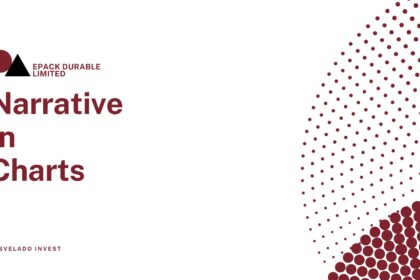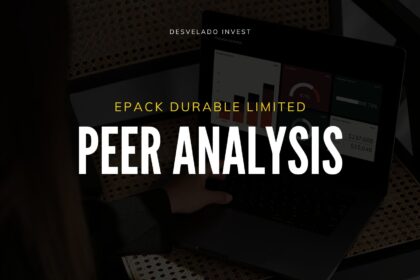NSE: EPACK

Porter’s Five Forces Analysis
Threat of New Entrants: Moderate
• The Indian RAC (Room Air Conditioner) market is growing rapidly, with a projected CAGR of 15.7% in value until FY 2027-28. This significant growth offers opportunities for new entrants, but the manufacturing of air conditioners requires significant capital investment and a diverse range of raw materials, posing substantial barriers to entry. {48}.
• The total capital requirement stands at ₹26.60 cr. approx. for establishing a manufacturing unit, which includes ₹4 cr. approx for a 4,000 sq.mtr. facility, ₹3 cr. Approx for plant and machinery, and a minimum of ₹18 crore approx. for two months of working capital. Additionally, the production process involves a variety of raw materials such as aluminum fin stock foil, copper tubes, and among. {49}
• To legally sell air conditioners in India, manufacturers must obtain BIS certification, ensuring compliance with safety, performance, and energy efficiency standards. The certification process takes about 1 month and involves submitting documents like test reports and factory details, with costs ranging from ₹28,000 approx. This certification is crucial for market entry and regulatory compliance. {50}
• Voltas, Blue Star, and LG are dominant players in the Indian air conditioning market. Voltas leads with a 35% market share, followed by LG with 16%, and Blue Star with 12%. These companies have established strong brand loyalty and a significant presence, creating substantial barriers for new entrants in the competitive RAC industry. {51}
• EPACK established this industry in 2003 and built a competitive advantage through backward integration, advanced product development, and strong R&D capabilities. To effectively compete in the market, new players would need to match or surpass these strengths.{52}.
• Established customer bases and retail networks give these companies a comprehensive distribution reach across India. New entrants would need to develop similar networks, which would involve negotiating with retailers and distributors, along with considerable investments and expertise in logistics management.
Bargaining Power of Buyers: High
• The RAC market in India is witnessing intense competition with numerous players such as LG, Daikin, and Samsung vying for market share. In FY 2022, the organized AC market was worth approximately INR 22,000 crore (USD 2.96 billion). This competitive landscape provides buyers with various options, thereby increasing their bargaining power. {53}
• Brand loyalty plays a critical role in customer purchasing decisions. A survey conducted in 2023 indicated that about 35% of customers prefer sticking to a brand they trust when purchasing air conditioning units. Companies like LG, BlueStar, Voltas, etc., with its long-standing presence, enjoy a loyal customer base, as evidenced by its approx. 70% market share in the commercial segment. {54}
• In the residential segment which is expected to increase at an increasing rate of 11% YOY, Customers exhibit significant price sensitivity. It is suggested that consumers are willing to switch brands in search of better pricing or promotional offers. For instance, about 60% of homeowners consider price as the primary factor while making purchases. {55}
• Large commercial clients often have substantial negotiating power due to their volume of purchases. In 2023, large enterprises account for 40% of the air conditioning market in India. This requires them to be flexible with pricing structures and provide discounts on bulk purchases to major clients, indicating the bargaining dynamics of customers. {56}
• EPACK primarily serves major brands in the consumer electronics and home appliances sectors, including well-known Indian and global brands like Dakin, Blue Star, harrier, etc. The company’s top 5 clients contributed 80-83% of revenue in H1FY24/FY23 this shows that there is a limited number of customers for EPACK which further increases the bargaining power of its buyers. {57}
Threat of Substitute Products: Moderate
• The threat of substitutes in the air conditioning market comes from substitutes like evaporative coolers, which are marketed as more affordable and energy efficient. The global evaporative cooler market, valued at USD 6.1 billion in 2021, is expected to grow to USD 8.5 billion by 2026, with a CAGR of 6.6%. In India, these coolers are particularly popular in arid and semi-arid regions with low humidity.{58}.
• The demand for sustainable and energy-efficient cooling solutions has increased significantly. In 2022, the global market for energy-efficient cooling systems was valued at USD 18.4 billion and is projected to grow to USD 27.9 billion by 2027, reflecting a compound annual growth rate (CAGR) of 8.5%. This creates a threat for manufacturers of RAC. {59}.
• The rise of smart home technologies is influencing consumer preferences, shifting demand toward smart air conditioning solutions. The global smart air conditioning market, growing at a CAGR of 20.2%. In India, around 30% of new air conditioning systems sold in urban areas were reported to feature smart capabilities in 2022, reflecting the growing adoption of these advanced technologies. {60}
• Substitutes for RACs include fans, air coolers, and other cooling solutions. These alternatives might be more appealing due to their lower cost or energy efficiency, But EPACK has recognized this threat and strategically diversified its product portfolio to include the SDA segment. {61}
Competitive Rivalry: High
• Voltas, Blue Star, and LG dominate the Indian air conditioning market, with Voltas leading at 35% market share, followed by LG at 16%, and Blue Star at 12%. Their strong brand loyalty and established presence create considerable challenges for new entrants in the competitive RAC industry.{62}
• Companies, like Blue Star, LG, and Voltas, are consistently investing in R&D to drive innovation. In 2022, Daikin allocated USD 1.3 billion to R&D, while LG committed USD 1 billion to advance energy efficiency and smart features in air conditioning systems, underscoring the industry’s focus on technological advancements which makes it difficult for the company to survive. {63}
• Companies differentiate themselves through service and warranty offerings. One company provides a standard 5-year warranty on its compressors, while another offers up to 10 years on select models. Service response times are also crucial, with one company targeting a 24-hour service response in urban areas, enhancing its competitive edge. {64}
• EPACK operates in a competitive industry with a limited number of customers. The fight for market share and attractive contracts intensifies rivalry among existing players. {65}
• Company aims to maintain its competitive edge by offering a wide range of products, increasing its R&D capabilities, and maintaining well-established customer relationships like EPACK. {66}
Bargaining Power of Suppliers: Moderate
• The RAC industry requires specialized components such as compressors, evaporators, and condensers, whereas the majority of companies like Voltas & LG, etc. rely heavily on a limited number of suppliers. Approximately 70% of the company’s specialized components are sourced from 5 key suppliers. This limited supplier base can lead to a significant dependency risk, whereby any disruption in supply can adversely impact production. {67}
• Strong relationships with major suppliers have allowed the company to secure favorable terms and ensure pricing stability. Approximately 60% of its procurement is based on long-term contracts, which help maintain price consistency. These partnerships enable better negotiations and a reliable supply chain. {68}
• There is a potential risk that key suppliers may pursue forward integration into manufacturing, increasing their bargaining power. In 2022, suppliers in the electrical components manufacturing segment held around 15% of the market share, suggesting a viable opportunity for them to enter the manufacturing sector by leveraging their capabilities. {69}
• Fluctuating raw material prices significantly impact supplier negotiations, raw material prices have varied by 10%-20%, affecting supplier margins and negotiation strategies. For example, copper has fluctuating prices like copper in 2020 was 3.2083(USD/Lbs) and 5.0265(USD/Lbs) in April 2024. {70}
• EPACK produces a wide range of components internally, including heat exchangers, fans, sheet metal parts, and more. This vertical integration reduces dependence on external suppliers and their potential bargaining power. The industry’s increasing focus on backward integration might also limit the influence of suppliers in the long term. {71}







